INVENTIONS PAGE
Disc-Jockey Slip Pads and Turntable Variable Speed Control for Russco Broadcast Turntables
Don also was experimenting with the use of variable speed, and while working at another club, Le Club Zanzibar, he had his technical friend Jim Miss create a device that could control the speed of the turntable motor so Don could create more complex mixes. Eventually Don used four turntables and was known for creating unique musical environments. Don still did not learn his lesson, and never did sell the devices he and Jim created. Soon Panasonic brought out Technic's turntables with the variable speed built in!
|
Biamp Don Blanton Signature Series Pro Disco Mixer
|
The Entertainment Manager System Plus - Automated Disc-Jockey System
The system incorporates two 19” touchscreen monitors and controls 300 CD’s with more than 6000 song selections, 72 Video Laser Discs - (up to 144 hours of American Bandstand TV Show clips), automated video advertising shown on 20 television screens throughout the restaurant & nightclub, 110 character generator screens that allows the staff to create their own video messages, lights, sound effects & audience participation games. The system is completely automatic or may be used with “live assist”. The system selects music according to a customizable format with 10 levels of dayparting. |
Warner Bros. Studio Stores - Cartoon Trivia Kiosk
|
Universal CityWalk Panasonic Astrovision Sign Content and Automation
|
FastCast - |
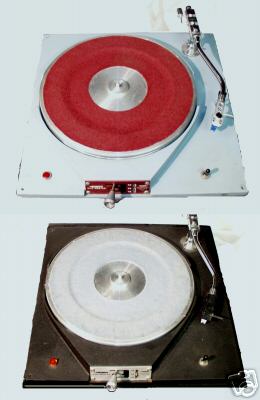 When dance clubs called "discos" first started appearing in the mid 70's, DJ's were using belt driven consumer turntables. When Don left radio to persue life as a DJ in clubs, he brought Russco Turntables with him to the disco scene. Belt driven turntables did not have enough torque to handle the sophisticated mixes that Don was experimenting with. Most DJ's didn't mix at that time in Washington, D.C., they just let the cue lever down on the track in the record and hoped for the best. So Don put the Russco turntables in a club called the Pier 9 in Washington D.C. and then went to a fabric store and bought a few yards of felt. He cut the felt to fit the turntable platter so he could slip cue the records while the platter was still spinning. Thus, he invented the slip pads. DJ's came from miles around to watch Don spin using his slip pads and his new mixing techniques. The club owners stopped letting people in, because that was Don's hook and the disco was packed because of Don's performances. Don's friend Guy O'Hazza wanted Don to sell the pads, but Don refused which was a big mistake. Someone else started selling slip pads and made a fortune!
When dance clubs called "discos" first started appearing in the mid 70's, DJ's were using belt driven consumer turntables. When Don left radio to persue life as a DJ in clubs, he brought Russco Turntables with him to the disco scene. Belt driven turntables did not have enough torque to handle the sophisticated mixes that Don was experimenting with. Most DJ's didn't mix at that time in Washington, D.C., they just let the cue lever down on the track in the record and hoped for the best. So Don put the Russco turntables in a club called the Pier 9 in Washington D.C. and then went to a fabric store and bought a few yards of felt. He cut the felt to fit the turntable platter so he could slip cue the records while the platter was still spinning. Thus, he invented the slip pads. DJ's came from miles around to watch Don spin using his slip pads and his new mixing techniques. The club owners stopped letting people in, because that was Don's hook and the disco was packed because of Don's performances. Don's friend Guy O'Hazza wanted Don to sell the pads, but Don refused which was a big mistake. Someone else started selling slip pads and made a fortune! 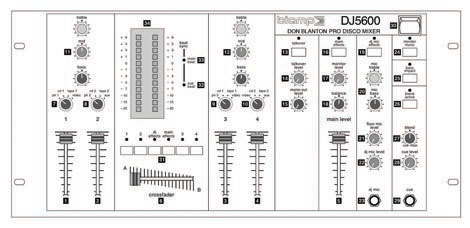
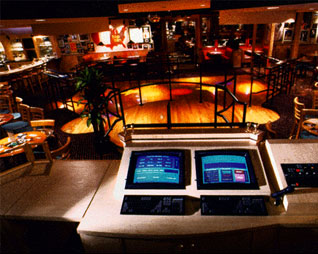 Don Blanton designed, created and was the chief programmer for this system which took approx. 8 years to complete. This version was created with Edwards Technologies for "Dick Clark's American Bandstand Grills". (Shown here with Don and Dick Clark)
Don Blanton designed, created and was the chief programmer for this system which took approx. 8 years to complete. This version was created with Edwards Technologies for "Dick Clark's American Bandstand Grills". (Shown here with Don and Dick Clark)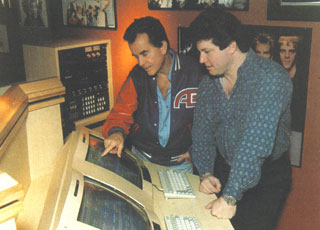
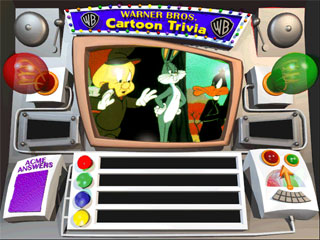 Don Blanton designed, created and was the chief programmer for this game system for Edwards Technologies. This system incorporated one 19” touchscreen monitor shown here with our proprietary Acme Control panel acts & feels as if you were controlling a cartoon. Buttons pop out in animation, you hear cartoon sound effects, buttons light, bells ring, bulges travel down wires, trap doors open etc. The system plays a 30-60 seconds of a cartoon clip displayed in a video window located in the center of the screen. After the cartoon clip plays the user is asked 1 of 500 trivia questions displayed randomly. The user touches one of the four colored buttons for his/her answer. If the answer is correct a bulge travels down the wire, the needle points to green, the green bulb lights and the bell rings. If the answer is false, the same thing happens with the exception that the red bulb lights and the bell rings on the other side. If the answer is false a trap door opens and an animated hand on a spring hits the correct colored button and the green bulb lights etc. This shows the user which answer was the correct one.
Don Blanton designed, created and was the chief programmer for this game system for Edwards Technologies. This system incorporated one 19” touchscreen monitor shown here with our proprietary Acme Control panel acts & feels as if you were controlling a cartoon. Buttons pop out in animation, you hear cartoon sound effects, buttons light, bells ring, bulges travel down wires, trap doors open etc. The system plays a 30-60 seconds of a cartoon clip displayed in a video window located in the center of the screen. After the cartoon clip plays the user is asked 1 of 500 trivia questions displayed randomly. The user touches one of the four colored buttons for his/her answer. If the answer is correct a bulge travels down the wire, the needle points to green, the green bulb lights and the bell rings. If the answer is false, the same thing happens with the exception that the red bulb lights and the bell rings on the other side. If the answer is false a trap door opens and an animated hand on a spring hits the correct colored button and the green bulb lights etc. This shows the user which answer was the correct one.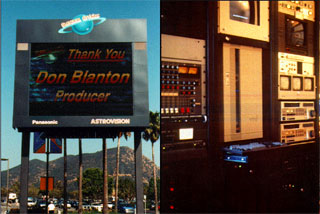 Don Blanton designed, created and was the chief programmer for this system for Edwards Technologies. Don would not allow Universal to purchase his automated system until Universal agreed to let Don produce the sign content. The approval came from the head of MCA at the time, the legendary Lew Wasserman!
Don Blanton designed, created and was the chief programmer for this system for Edwards Technologies. Don would not allow Universal to purchase his automated system until Universal agreed to let Don produce the sign content. The approval came from the head of MCA at the time, the legendary Lew Wasserman!